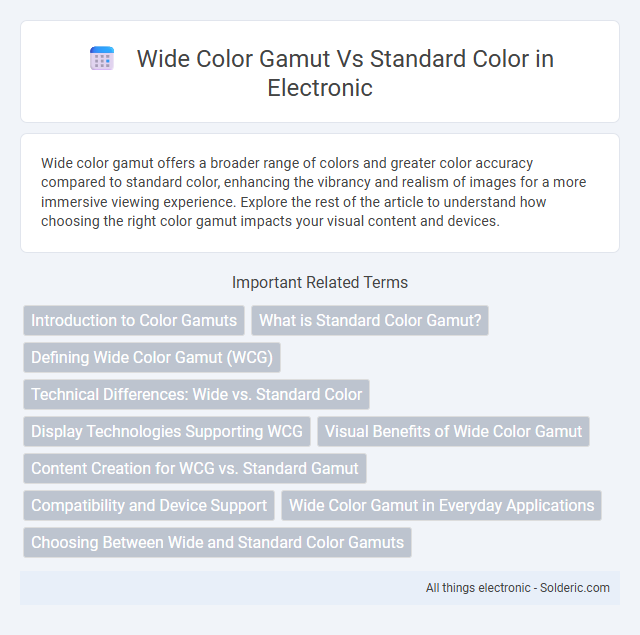Wide color gamut offers a broader range of colors and greater color accuracy compared to standard color, enhancing the vibrancy and realism of images for a more immersive viewing experience. Explore the rest of the article to understand how choosing the right color gamut impacts your visual content and devices.
Comparison Table
| Feature | Wide Color Gamut (WCG) | Standard Color Gamut (sRGB) |
|---|---|---|
| Color Range | Expands beyond sRGB, covers up to 90%+ of DCI-P3 or Rec. 2020 | Covers approximately 35% of visible colors, based on sRGB standard |
| Color Accuracy | Higher accuracy, supports richer, more vibrant colors | Moderate accuracy, suitable for web and basic displays |
| Use Cases | Professional photo/video editing, cinema, HDR content | General computing, standard web media, documents |
| Display Support | Advanced displays with OLED, Quantum Dot, or HDR technology | Most conventional LCD & LED displays |
| File Compatibility | Requires color-managed workflows, formats like HDR10, Rec. 2020 | Universal compatibility, JPEG, PNG optimized for sRGB |
| Visual Impact | More vivid, lifelike visuals with deeper saturation | Standard visuals, less saturated, suitable for general viewing |
Introduction to Color Gamuts
Wide Color Gamut (WCG) encompasses a broader spectrum of colors compared to Standard Color Gamuts like sRGB, enabling more vivid and lifelike visuals. WCG technologies, such as DCI-P3 and Rec. 2020, expand color representation for applications in displays, digital cinema, and HDR content. Accurate color gamuts enhance image quality by reproducing deeper reds, richer greens, and more saturated blues, crucial for immersive media and professional imaging workflows.
What is Standard Color Gamut?
Standard Color Gamut refers to the range of colors that can be accurately represented by most traditional display devices, typically defined by the sRGB color space. It covers a narrower spectrum compared to Wide Color Gamut, which includes a broader range of colors, resulting in more vibrant and lifelike images. Understanding the limitations of Standard Color Gamut can help you choose displays or content that better suit your needs for color accuracy and richness.
Defining Wide Color Gamut (WCG)
Wide Color Gamut (WCG) refers to a broader range of colors that can be displayed compared to Standard Color gamuts like sRGB. WCG encompasses advanced color spaces such as DCI-P3 and Adobe RGB, which capture more saturated and diverse hues, enhancing visual realism and vibrancy. This technology is crucial for HDR content, professional photography, video production, and high-end displays requiring accurate and vivid color reproduction.
Technical Differences: Wide vs. Standard Color
Wide Color Gamut (WCG) displays encompass a broader range of colors by extending beyond the standard Rec. 709 color space, covering wider spectrums like DCI-P3 or Rec. 2020, which standard color displays use. This technical difference means WCG can reproduce more vibrant and saturated hues with finer gradations, enhancing visual depth and realism in images. Your viewing experience improves significantly with WCG, delivering richer colors and sharper contrasts compared to the limited palette of standard color displays.
Display Technologies Supporting WCG
Wide Color Gamut (WCG) display technologies, such as OLED, QLED, and Quantum Dot LCDs, support a broader spectrum of colors compared to Standard Color Gamut (sRGB) displays. These advanced displays utilize enhanced backlighting and color filters to achieve higher color volume and more vibrant, accurate color reproduction, enabling richer visuals for HDR content and professional-grade media. Devices with WCG support comply with standards like DCI-P3 and Rec. 2020, offering superior color fidelity for gaming, video production, and immersive viewing experiences.
Visual Benefits of Wide Color Gamut
Wide Color Gamut (WCG) enhances visual experiences by displaying a broader spectrum of colors compared to Standard Color, resulting in richer, more vivid images with greater depth and realism. This expanded range allows for more accurate reproduction of subtle color nuances, especially in high dynamic range (HDR) content, improving overall picture quality. WCG technology is essential for modern displays, providing immersive visuals that closely match real-world scenes.
Content Creation for WCG vs. Standard Gamut
Wide Color Gamut (WCG) enhances content creation by providing a broader spectrum of colors, enabling more accurate and vibrant visuals compared to the Standard Color Gamut. Creators working with WCG can achieve greater color precision and depth in digital media, which is essential for high-end video production, photography, and graphic design. Standard Gamut content, limited by a narrower color range, often results in less dynamic imagery and may require color grading adjustments when converted for WCG displays.
Compatibility and Device Support
Wide Color Gamut (WCG) offers richer and more vibrant colors compared to Standard Color, but its compatibility depends heavily on device support, including monitors, TVs, and software that can process extended color profiles like DCI-P3 or Rec. 2020. Many older devices and applications remain limited to Standard Color spaces such as sRGB, which may cause color shifts or reduced visual fidelity when displaying WCG content. Ensuring your hardware and software support Wide Color Gamut is essential for experiencing accurate and enhanced color reproduction.
Wide Color Gamut in Everyday Applications
Wide Color Gamut (WCG) technology enhances everyday applications by delivering richer, more vibrant colors that closely mimic real-world visuals, significantly improving user experience in photo editing, video streaming, and gaming. Devices supporting WCG capture and display a broader spectrum of colors compared to Standard Color, resulting in more accurate and lifelike images. This expanded color range benefits industries such as digital media, entertainment, and design, where color precision is critical.
Choosing Between Wide and Standard Color Gamuts
Choosing between wide color gamut and standard color gamuts depends on your display needs and color accuracy requirements. Wide color gamut offers richer, more vibrant colors by covering a broader spectrum such as DCI-P3 or Adobe RGB, while standard color gamut typically covers sRGB, suitable for everyday use and web content. For professionals working with photo or video editing, wide color gamut ensures true-to-life hues, whereas casual users may find standard gamut satisfactory for general media consumption.
Wide Color Gamut vs Standard Color Infographic

 solderic.com
solderic.com